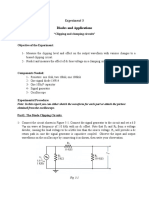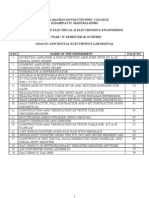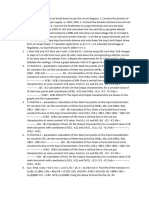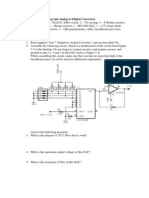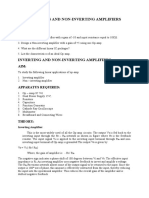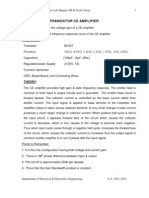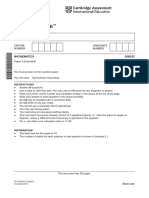0 ratings0% found this document useful (0 votes)
273 viewsChapter 3 - Operational Amplifiers: Experiment 3.1 - Inverter Amplifier
Chapter 3 - Operational Amplifiers: Experiment 3.1 - Inverter Amplifier
Uploaded by
Ishaku BalamiThis document outlines experiments on operational amplifiers, including constructing and measuring:
1) An inverting amplifier, measuring gain and phase shift
2) A non-inverting amplifier and follower amplifier, again measuring gain and phase shift
3) Summing and difference amplifiers, recording input-output voltage relationships
The experiments are designed to familiarize students with basic op-amp circuits, parameters like gain and input/output impedances, and analyzing signals using an oscilloscope.
Copyright:
Attribution Non-Commercial (BY-NC)
Available Formats
Download as DOCX, PDF, TXT or read online from Scribd
Chapter 3 - Operational Amplifiers: Experiment 3.1 - Inverter Amplifier
Chapter 3 - Operational Amplifiers: Experiment 3.1 - Inverter Amplifier
Uploaded by
Ishaku Balami0 ratings0% found this document useful (0 votes)
273 views44 pagesThis document outlines experiments on operational amplifiers, including constructing and measuring:
1) An inverting amplifier, measuring gain and phase shift
2) A non-inverting amplifier and follower amplifier, again measuring gain and phase shift
3) Summing and difference amplifiers, recording input-output voltage relationships
The experiments are designed to familiarize students with basic op-amp circuits, parameters like gain and input/output impedances, and analyzing signals using an oscilloscope.
Original Title
EE315
Copyright
© Attribution Non-Commercial (BY-NC)
Available Formats
DOCX, PDF, TXT or read online from Scribd
Share this document
Did you find this document useful?
Is this content inappropriate?
This document outlines experiments on operational amplifiers, including constructing and measuring:
1) An inverting amplifier, measuring gain and phase shift
2) A non-inverting amplifier and follower amplifier, again measuring gain and phase shift
3) Summing and difference amplifiers, recording input-output voltage relationships
The experiments are designed to familiarize students with basic op-amp circuits, parameters like gain and input/output impedances, and analyzing signals using an oscilloscope.
Copyright:
Attribution Non-Commercial (BY-NC)
Available Formats
Download as DOCX, PDF, TXT or read online from Scribd
Download as docx, pdf, or txt
0 ratings0% found this document useful (0 votes)
273 views44 pagesChapter 3 - Operational Amplifiers: Experiment 3.1 - Inverter Amplifier
Chapter 3 - Operational Amplifiers: Experiment 3.1 - Inverter Amplifier
Uploaded by
Ishaku BalamiThis document outlines experiments on operational amplifiers, including constructing and measuring:
1) An inverting amplifier, measuring gain and phase shift
2) A non-inverting amplifier and follower amplifier, again measuring gain and phase shift
3) Summing and difference amplifiers, recording input-output voltage relationships
The experiments are designed to familiarize students with basic op-amp circuits, parameters like gain and input/output impedances, and analyzing signals using an oscilloscope.
Copyright:
Attribution Non-Commercial (BY-NC)
Available Formats
Download as DOCX, PDF, TXT or read online from Scribd
Download as docx, pdf, or txt
You are on page 1of 44
Chapter 3 - Operational Amplifiers
Experiment 3.1 - Inverter Amplifier
Objectives:
- The operational amplifier.
- Constructing an inverter amplifier.
- Measuring amplifier parameters.
Equipment required:
- Analog trainer
- Power supply
- A multitester
- Jumper wires
- LM358 or 741
- Resistors: 2 x 1K, 4.7K, 10K
Procedure:
Step 1: Connect the analog trainer to the power supply and the power supply to the
Mains.
Inverting Amplifier:
Step 2: Implement the following circuit:
Circuit for single voltage power supply:
+12V
-12V
V
o
V
i
10K
4.7K
+
-
Step 3: Connect V
i
to the variable voltage source, change the input voltage V
i
, measure
the output voltage V
o
and fill in the following table.
31 31 33 31 9 8 7 6 5 4 1 1 3 No.
6 5 4 3 2 1 0 -1 -2 -3 -4 -5 -6 V
i
V
o
A
V
+12V
V
o
V
i
10K
4.7K
+
-
+12V
1K
1K
Step 4: Plot your results on the following graph.
Step 5: Connect the V
i
terminal of the operational amplifier to the OUT output terminal
of the function generator. Adjust the function generator to 1Vp-p 1KHz sine
wave.
Note:
The TPS-3371 trainer does not include a power supply for negative voltage. The
experiments can be performed with a single voltage power supply. In this case, the V
input is connected to the GND and the non-inverter input is connected to the voltage
divider with two equals resistors of the power supply voltage.
Step 6: Connect the scope probe CH1 to the oscillator output and the CH2 probe to the
amplifier output.
Step 7: Plot the scope picture on the following graph:
V
o
V
i
t
VCH1
t
VCH1
Step 8: What is the phase shift between the signals?
Step 9: Implement the following circuit:
Circuit for single voltage power supply:
Step 10: Connect the function generator output as V
S
.
Step 11: Measure the voltages V
C
(V
o
), V
RS
and V
i
, with AC voltmeter.
Step 12: Connect a 1K resistor between V
o
and ground. This resistor acts as R
L
.
Measure V
L
.
Step 13: Calculate and record the A
V
, A
I
, R
i
, R
o
according to your measurements and to
paragraph 3.1.4.
+12V
-12V
V
o
V
S
10K
4.7K
+
-
1K
R
S
R
2
Vi
+12V
V
o
+
-
+12V
1K
1K
V
S
4.7K 1K
R
S
R
1
10K
R
2
Vi
Experiment report:
1) Write the name of each experiment and draw below the electronic circuit.
For each circuit include the experiment measurements, results and graphs.
2) Compare between the preliminary questions and the examples with the measurement
results.
Experiment 3.2 - Non Inverter & Follower
Amplifier
Objectives:
- Constructing and measuring a comparator amplifier.
- Constructing and measuring a non inverter amplifier.
Equipment required:
- Analog trainer
- Power supply
- A multitester
- An oscilloscope or PC with SESCOPE
- Jumper wires
- LM358 or 741
- Resistors: 1K, 4.7K, 10K
Procedure:
Step 1: Connect the analog trainer to the power supply and the power supply to the
Mains.
Non Inverting Amplifier:
Step 2: Implement the following circuit:
V
i
V
o
+
-
R
1
10K
R
2
4.7K
+12V
-12V
Step 3: Connect V
i
to the variable voltage source, change the input voltage V
i
, measure
the output voltage V
o
and fill in the following table.
31 31 33 31 9 8 7 6 5 4 1 1 3 No.
6 5 4 3 2 1 0 -1 -2 -3 -4 -5 -6 V
i
V
o
A
V
Step 4: Plot your results on the following graph.
Step 5: Supply 6V to V
i
input.
Step 6: Measure the voltage on R
2
(4.7K) and calculate its current.
Step 7: Change R
2
to 1K.
V
o
V
i
Step 8: Measure the voltage on R
2
and calculate its current.
Does changing R
2
value affects its current?
Step 9: Change V
i
voltage to 3V.
Step 10: Measure the voltage on R
2
and calculate its current.
Step 11: Draw your conclusions.
Step 12: Connect the V
i
terminal of the operational amplifier to the output terminal of the
function generator. Adjust the function generator to 2Vp-p 1KHz sine wave.
Step 13: Connect the scope probe CH1 to the oscillator output and the CH2 probe to the
amplifier output. Adjust the oscillator potentiometers until you form smooth
sinusoidal waves on both channels.
Step 14: Plot the scope picture on the following graph:
t
VCH1
t
VCH1
Step 15: What is the phase shift between the signals?
Step 16: Implement the following circuit:
Step 17: Connect the function generator output as V
S
.
Step 18: Measure the voltages V
C
(V
o
), V
RS
and V
i
, with AC voltmeter.
Step 19: Connect a 1K resistor between V
o
and ground. This resistor acts as R
L
.
Measure V
L
.
Step 20: Calculate and record the A
V
, A
I
, R
i
, R
o
according to your measurements and to
paragraph 3.1.4.
Follower Amplifier:
Step 21: Implement the following circuit:
+12V
-12V
V
i
V
o
-
+
V
S
V
o
+
-
R
1
10K
R
2
4.7K
+12V
-12V
R
S
1K
V
i
Step 22: Connect V
i
to the variable voltage source, change the input voltage V
i
, measure
the output voltage V
o
and fill in the following table.
31 31 33 31 9 8 7 6 5 4 1 1 3 No.
6 5 4 3 2 1 0 -1 -2 -3 -4 -5 -6 V
i
V
o
A
V
Step 23: Plot your results on the following graph.
Step 24: Connect the V
i
terminal of the operational amplifier to the output terminal of the
function generator. Adjust the function generator to 2Vp-p 1KHz sine wave.
Step 25: Connect the scope CH1 to the oscillator output and the CH2 to the amplifier
output.
Step 26: Plot the scope picture on the following graph:
V
o
V
i
t
VCH1
t
VCH1
Step 27: What is the phase shift between the signals?
Step 28: Implement the following circuit:
Step 29: Measure the voltages V
C
(V
o
), V
RS
and V
i
, with AC voltmeter.
Step 30: Connect a 1K resistor between V
o
and ground. This resistor acts as R
L
.
Measure V
L
.
Step 31: Calculate and record the A
V
, A
I
, R
i
, R
o
according to your measurements and to
paragraph 3.1.4.
Experiment report:
1) Write the name of each experiment and draw below the electronic circuit.
For each circuit include the experiment measurements, results and graphs.
2) Compare between the preliminary questions and the examples with the measurement
results.
Experiment 3.3 - Summing & Difference
Amplifiers
Objectives:
- Constructing and measuring a summing amplifier.
- Constructing and measuring a difference amplifier.
Equipment required:
- Analog trainer
- Power supply
- A multitester
- An oscilloscope or PC with SESCOPE
- Jumper wires
+12V
-12V
V
o
-
+ V
S
R
S
1K
V
i
- LM358 or 741
- Resistors: 2 x 1K, 4.7K, 2 x 10K, 100K
Procedure:
Step 1: Connect the analog trainer to the power supply and the power supply to the
Mains.
Summing Amplifier:
Step 2: Implement the following circuit on the main plug in board.
Circuit for single voltage power supply:
4.7K
V
1
10K
V
2
V
o
-
+
100K
+12V
-12V
4.7K
V
1
10K
V
2
V
o
-
+
100K
+12V
1K
1K
+12V
Step 3: Turn ON the trainer.
Step 4: Connect V
2
to +12V terminal.
Step 5: Connect V
1
to the variable voltage source.
Step 6: Change the input voltage V
1
and measure the output voltage V
o
and fill in the
following table.
13 12 11 10 9 8 7 6 5 4 3 2 1 No.
3 2.5 2 1.5 1 0.5 0 -0.5 -1 -1.5 -2 -2.5 -3 V
1
V
o
Step 7: Draw your conclusions.
Step 8: Connect the V
1
terminal of the operational amplifier to the output terminal of the
function generator. Adjust the function generator to 3Vp-p 1KHz sine wave.
Step 9: Connect the scope CH1 to the generator OUT output and the CH2 to the amplifier
output.
Step 10: Plot the scope picture on the following graph:
t
VCH1
t
VCH1
Difference Amplifier:
Step 11: Implement the following circuit:
Step 12: Connect V
2
to +5V terminal.
Step 13: Connect V
1
to the variable voltage source.
Step 14: Change the input voltage V
1
and measure the output voltage V
o
and fill in the
following table.
13 12 11 10 9 8 7 6 5 4 3 2 1 No.
3 2.5 2 1.5 1 0.5 0 -0.5 -1 -1.5 -2 -2.5 -3 V
1
V
o
Step 15: Draw your conclusions.
Step 16: Connect the V
1
terminal of the operational amplifier to the OUT output terminal
of the function generator. Adjust the function generator to 8Vp-p 1KHz sine
wave.
Step 17: Connect the scope CH1 to the generator output and the CH2 to the amplifier
output.
V
1
V
2
-
+
10K
10K
4.7K
4.7K
+12V
-12V
Step 18: Plot the scope picture on the following graph:
Experiment report:
1) Write the name of each experiment and draw below the electronic circuit.
For each circuit include the experiment measurements, results and graphs.
2) Compare between the preliminary questions and the examples with the measurement
results.
t
VCH1
t
VCH1
Experiment 3.4 - Comparator & Schmitt
Trigger Comparator
Objectives:
- Constructing and measuring a comparator amplifier.
- Constructing and measuring a comparator amplifier.
Equipment required:
- Analog trainer
- Power supply
- A multitester
- An oscilloscope or PC with SESCOPE
- Jumper wires
- LM358 or 741
- Resistors: 2 x 1K, 4.7K, 10K
Procedure:
Step 1: Connect the analog trainer to the power supply and the power supply to the
Mains.
Comparator Amplifier:
Step 2: Implement the following circuit on the main plug in board.
V
i
V
o
+
-
+12V
-12V
Circuit for single voltage power supply:
Step 3: Turn ON the trainer.
Step 4: Change the input voltage V
i
and measure the output voltage V
o
and fill in the
following table.
31 31 33 31 9 8 7 6 5 4 1 1 3 No.
6 5 4 3 2 1 0 -1 -2 -3 -4 -5 -6 V
i
V
o
V
i
V
o
+
-
+12V
1K
1K
+12V
Step 5: Plot your results on the following graph.
Step 6: Connect the V
i
terminal of the operational amplifier to the OUT e output terminal
of the function generator. Adjust the function generator to 8Vp-p 1KHz sine
wave.
Step 7: Connect the scope CH1 to the generator output and the CH2 to the amplifier
output.
Step 8: Plot the scope picture on the following graph:
V
o
V
i
t
VCH1
t
VCH1
Schmitt Trigger Comparator:
Step 9: Implement the following circuit:
Circuit for single voltage power supply:
V
i
V
o
-
+
R
1
R
2
4.7K
10K
+12V
-12V
+12V
V
i
V
o
-
+
R
1
R
2
4.7K
10K
4.7K
+12V
Step 10: Connect the V
i
terminal of the operational amplifier to the OUT output terminal
of the function generator.
Step 11: Connect the scope CH1 to the generator OUT output and the CH2 to the amplifier
output.
Step 12: Plot the scope picture on the following graph:
Experiment report:
1) Write the name of each experiment and draw below the electronic circuit.
For each circuit include the experiment measurements, results and graphs.
2) Compare between the preliminary questions and the examples with the measurement
results.
Experiment 3.5 - Integrator & Differentiator
Amplifiers
Objectives:
- Constructing and measuring an integrator amplifier.
- Constructing and measuring a differentiator amplifier.
Equipment required:
- Analog trainer
- Power supply
- A multitester
- An oscilloscope or PC with SESCOPE
- Jumper wires
- LM358 or 741
t
VCH1
t
VCH1
- Resistors: 1K, 10K
- Capacitors: 2 x 0.1F
Procedure:
Step 1: Connect the analog trainer to the power supply and the power supply to the
Mains.
Integrator Amplifier:
Step 2: Implement the following circuit on the main plug in board.
Step 3: Turn ON the trainer.
Step 4: Connect the V
i
terminal of the operational amplifier to the OUT e output terminal
of the function generator. Adjust the function generator to 4Vp-p 1KHz sine
wave.
Step 5: Connect the scope CH1 to the generator output and the CH2 to the amplifier
output.
V
o
V
i
0.1F
1K
+
-
+12V
-12V
Step 6: Plot the scope picture on the following graph:
t
VCH1
t
VCH1
Step 7: Change the generator signal to triangle wave of 1KHz and 1Vp-p and plot the
scope picture.
Step 8: Explain the results.
Differentiator Amplifier:
Step 9: Implement the following circuit:
Step 10: Connect the V
i
terminal of the operational amplifier to the OUT output terminal
of the function generator. Adjust the function generator to 8Vp-p 700Hz sine
wave.
Step 11: Connect the scope CH1 to the generator output and the CH2 to the amplifier
output.
Step 12: Plot the scope picture on the following graph:
+12V
-12V
V
o
V
i
1K
0.1F
+
-
0.1F 10K
t
VCH1
VCH1
Step 13: Change the generator signal to triangle wave of 1KHz and 1Vp-p and plot the
scope picture.
Step 14: Explain the results.
Experiment report:
1) Write the name of each experiment and draw below the electronic circuit.
For each circuit include the experiment measurements, results and graphs.
2) Compare between the preliminary questions and the examples with the measurement
results.
Experiment 3.6 - Oscillators
Objectives:
- An amplifier with positive feedback.
- Constructing and measuring a Wein bridge oscillator.
- Constructing and measuring a square wave oscillator.
- Constructing and measuring a triangle wave oscillator.
Equipment required:
- Analog trainer
- Power supply
- A multitester
- An oscilloscope or PC with SESCOPE
- Jumper wires
- LM358 or 741
- Resistors: 2 x 1K, 4.7K, 10K, 2 x 100K
- Capacitors: 2 x 0.1F
- Potentiometer 10K
- Coils: 2 x 47Hy
Procedure:
Step 1: Connect the analog trainer to the power supply and the power supply to the
Mains.
Wein bridge oscillator:
Step 2: Implement the following circuit on the main plug in board.
Use the following values:
R
1
= 100KO Potentiometer
R
2
= 10KO
R
3
= 1.5KO
R
4
= 1.5KO
C
1
= 0.1F
C
2
= 0.1F
Step 3: Turn ON the trainer.
Step 4: Connect the scope probe CH1 to the oscillator output.
Step 5: Adjust the oscillator potentiometer until you form smooth sinusoidal waves on
the oscillator output.
Step 6: Measure the signal frequency. Compare the measured value with the calculated
value.
R
2
Z
2
C
2
Z
1
C
1
V
o
R
1
+
-
R
4
R
3
-12V
+12V
2
3
8
4
1
Square wave oscillator:
Step 7: Implement the following circuit on the main plug in board.
Use the following values:
R
1
= 100KO
R
2
= 4.7KO
R
3
= 100KO
C = 0.1F
Step 8: Connect the scope probe CH1 to the oscillator output.
Step 9: Measure the signal frequency. Compare the measured value with the calculated
value.
Step 10: Connect CH2 to the V
A
. Observe the signal on it.
V
A
C
V
o
R
+
-
R
2
R
1
V
B
+12V
-12V
Triangle wave oscillator:
Step 11: Implement the following circuit on the main plug in board.
Use the following values:
R
1
= 100KO
R
2
= 10KO
R
3
= 7.4KO
C = 0.1F
Step 12: Connect the scope probe CH1 to the oscillator output.
Step 13: Measure the signal frequency. Compare the measured value with the calculated
value.
Step 14: Connect CH2 to the V
B
. Observe the signal on it.
+12V
-12V
47H
R
1
R
1
V
o
C
+
-
+
-
A
3
A
1
V
B
+12V
-12V
47H
R
2
Experiment report:
1) Write the name of each experiment and draw below the electronic circuit.
For each circuit include the experiment measurements, results and graphs.
2) Compare between the preliminary questions and the examples with the measurement
results.
Experiment 3.7 - Band Pass Filter
Objectives:
- Transmission of signals at different frequencies through a band pass filter.
- Measurement and calculation of the filter bandwidth.
- Spectral analysis of the response curve.
Equipment required:
- Analog trainer
- Power supply
- An oscilloscope or PC with SESCOPE
- Banana wires
- LM358 or 741
- Resistors: 100O, 1K, 4.7K
- Capacitors: 2 x 0.1F
Procedure:
Step 1: Connect the kit to the power supply.
Step 2: Connect the power supply to the electricity and turn it ON.
Step 3: Implement the following band pass filter.
Step 4: Set the High/Low switch to the Low position.
This position set the function generator frequency range to 600KHz 8KHz.
Step 5: Set the Triangle/Sine switch to the Sine position.
Step 6: Set the Sweep/Const switch to the Const position.
+12V
S
o
S
i
C
4
0.1
C
3
0.1
R
1
1K
R
2
100
+
-
R
5
4.7K
-12V
Step 7: Connect the function generator output (OUT) to the band pass filter input.
Step 8: Connect the scope CH1 to the filter input.
Step 9: Connect the scope CH2 to the filter output.
Use the Alternate (Alt) mode for maximum quality.
Step 10: Raise the frequency on the generator until you obtain a sine wave of maximum
amplitude at the filter output.
Measure this amplitude and record it.
Record the amplitude of the input voltage to the filter, as well.
Step 11: Record the frequency of the signal in this state. The frequency should be
approximately 2.3KHz.
Signal
Generator
BPF
Sin Sout
CH1
CH2
Scope
Step 12: Raise the frequency until you receive a signal at an amplitude of 0.7Vmax. Make sure
that the input voltage remains unchanged.
Record the frequency of the signal received.
Step 13: Lower the frequency so that the signal intensity at the output rises and then decreases
until we again obtain an amplitude of 0.7Vmax.
Make sure that the input voltage remains unchanged.
Record the frequency of the signal received.
Step 14: Calculate and record the filter bandwidth.
Step 15: Calculate the quality factor of the filter:
f
f
Q
0
A
=
Step 16: Complete the following table:
V
in
= 2Vp-p
F
(
K
H
z
)
5 3
1
3
5
1
1
1
1
1
4
1
6
1
8
1
1
1
1
1
4
1
6
1
8
4
1
4
5
5
1
5
5
Voutp
-
p
With every measurement, check that the amplitude of the input voltage remains the
same.
Step 17: Draw the response curve of the filter.
Step 18: Mark the half-power-point frequencies on the response curve.
Step 19: Implement the following low pass filter.
V
o
V
i
R
-
+
C
R= 1K
C= 0.1F
Step 20: Repeat steps 7-18 with this filter.
Step 21: Implement the following high pass filter.
R= 1K
C= 0.1F
Step 22: Repeat steps 7-18 with this filter.
Experiment report:
1) Gather together all the results of your experiments and measurements. Record the name of
the experiment and the illustration of the circuit measured above the experiment results in
the table.
2) Compare the measured value with the calculated value.
V
o
V
i
-
+
C
R
You might also like
- Free and Forced Convection Lab ReportDocument33 pagesFree and Forced Convection Lab ReportMoWatts1785% (46)
- Baramati MIDC CompaniesDocument2 pagesBaramati MIDC CompaniesDeepak Nair67% (6)
- Basic Electronics PracticalDocument9 pagesBasic Electronics Practicalasfadare100% (2)
- Lab Experiment 8Document8 pagesLab Experiment 8Meredith Jensen0% (1)
- Experiment: Title: DC Power Supply Unit: Transformer ObjectiveDocument14 pagesExperiment: Title: DC Power Supply Unit: Transformer ObjectiveLian Ai Chen100% (1)
- ALMOST HALF DONE Experiment 5 Clamping and ClippingDocument16 pagesALMOST HALF DONE Experiment 5 Clamping and ClippingAyeshaNo ratings yet
- Halzen & Martin - Quarks and Leptons.Document412 pagesHalzen & Martin - Quarks and Leptons.sillyblob100% (1)
- PP03 - Asep - NSCP 2015 Update On CH2 Minimum Design Loads PDFDocument71 pagesPP03 - Asep - NSCP 2015 Update On CH2 Minimum Design Loads PDFCarlo Joseph92% (26)
- Electronics 1 Lab Manual PDFDocument30 pagesElectronics 1 Lab Manual PDFAnonymous 7y7TeR0% (1)
- ECAD2 Complete ManualDocument37 pagesECAD2 Complete ManualJeremy HensleyNo ratings yet
- Ece Ade Manual 500 CopiesDocument79 pagesEce Ade Manual 500 CopiesRajkumarNo ratings yet
- Experiment EG220Document30 pagesExperiment EG220Ishaku Balami67% (6)
- Ade Lab ManualDocument79 pagesAde Lab ManualVinod KannaNo ratings yet
- Design of Electrical Circuits using Engineering Software ToolsFrom EverandDesign of Electrical Circuits using Engineering Software ToolsNo ratings yet
- Experiment 2 Wave Shaping CircuitsDocument9 pagesExperiment 2 Wave Shaping CircuitsMaria Abia Lapena50% (2)
- Connecting The Circuit On Bread Board As Per The Circuit DiagramDocument3 pagesConnecting The Circuit On Bread Board As Per The Circuit Diagramhmpudur1968No ratings yet
- Push Pull Ampilfier - c9Document4 pagesPush Pull Ampilfier - c9quynh04cdt1No ratings yet
- Operational Amplifi Ers: ExperimentDocument4 pagesOperational Amplifi Ers: Experimentampalacios1991No ratings yet
- A. DC Operations I. ObjectivesDocument8 pagesA. DC Operations I. ObjectivesdummyNo ratings yet
- (Experiment 7) Operational Amplifier - Basic Op-Amp Circuit (Comparator, Summing, Integrators, and Differentiators) PDFDocument13 pages(Experiment 7) Operational Amplifier - Basic Op-Amp Circuit (Comparator, Summing, Integrators, and Differentiators) PDFArik JuniarNo ratings yet
- EE331 Lab 2 v2Document11 pagesEE331 Lab 2 v2SonDinhQuangNo ratings yet
- Common Collector Circuit - DC OperationDocument7 pagesCommon Collector Circuit - DC OperationDebbie ComissionNo ratings yet
- AEC LabManualDocument30 pagesAEC LabManualPrateek PaliwalNo ratings yet
- Lab Exercise:use of LM 311 As Precision Comparator and Window Detector & Triangle Wave Generator PDFDocument3 pagesLab Exercise:use of LM 311 As Precision Comparator and Window Detector & Triangle Wave Generator PDFmrana_56No ratings yet
- Ec1 Lab Manual PDFDocument44 pagesEc1 Lab Manual PDFpardhu_y4No ratings yet
- EE211 Digital-to-Analog and Analog-to-Digital ConvertersDocument3 pagesEE211 Digital-to-Analog and Analog-to-Digital ConvertersPower DoddNo ratings yet
- Zero Crossing Detector and Window DetectorDocument7 pagesZero Crossing Detector and Window DetectorTimoth Dev50% (2)
- A4Exp2-I EDocument5 pagesA4Exp2-I EEE1INCOMIONo ratings yet
- EXP6Document10 pagesEXP6fatih_ealNo ratings yet
- Lab1 DiodesDocument4 pagesLab1 DiodesDavid TandjayaNo ratings yet
- Analogue EEC436Document46 pagesAnalogue EEC436Akachi OkoroNo ratings yet
- Experiment 1 Non-Inverting Amplifier 9.1 ObjectiveDocument7 pagesExperiment 1 Non-Inverting Amplifier 9.1 Objectiveyoungdiana023No ratings yet
- Mosfet TransistorsDocument6 pagesMosfet Transistorssyedur92No ratings yet
- Edc Lab ManualDocument70 pagesEdc Lab ManualreneeshczNo ratings yet
- Experiment No: 04 Experiment Name: Summing Amplifire. Aim: To Design and Setup A Summing Amplifier Circuit With OP AMPDocument4 pagesExperiment No: 04 Experiment Name: Summing Amplifire. Aim: To Design and Setup A Summing Amplifier Circuit With OP AMPjif 1310100% (1)
- Inverting and Non-Inverting Amplifiers: Pre-Lab QuestionsDocument13 pagesInverting and Non-Inverting Amplifiers: Pre-Lab QuestionsBereket TsegayeNo ratings yet
- Lica Lab ManualDocument35 pagesLica Lab ManualVallabh JNo ratings yet
- Lab10 2011Document5 pagesLab10 2011Venkat RamananNo ratings yet
- Experiment 2 - Half Wave RectifierDocument8 pagesExperiment 2 - Half Wave RectifierRandred GarciaNo ratings yet
- Summing AmplifiersDocument5 pagesSumming Amplifierscedgee100% (2)
- Ica Lab (135) Iii-IDocument87 pagesIca Lab (135) Iii-IesesesNo ratings yet
- List of Experiments: Ic Applications Lab Minimum Twelve Experiments To Be ConductedDocument6 pagesList of Experiments: Ic Applications Lab Minimum Twelve Experiments To Be ConductedAmy OliverNo ratings yet
- Lab6 BJT AmplifierDocument5 pagesLab6 BJT Amplifierkostia1100% (1)
- 09 Inverting Schmitt TriggerDocument6 pages09 Inverting Schmitt TriggerMocanu Vicentiu-AdrianNo ratings yet
- Updated Manual - FinalDocument25 pagesUpdated Manual - FinalSaiyma Fatima RazaNo ratings yet
- NRI Discovery LabDocument19 pagesNRI Discovery Labden headNo ratings yet
- STP 211 Practical-1-1-1-1-1Document25 pagesSTP 211 Practical-1-1-1-1-1Abdulaziz MuhammedNo ratings yet
- Operational Amplifier LAbDocument17 pagesOperational Amplifier LAbAhmad DboukNo ratings yet
- Penguat Kolektor BersamaDocument4 pagesPenguat Kolektor Bersamaicharahma520No ratings yet
- Esd ManualDocument32 pagesEsd ManualNasrin Rafee100% (1)
- Laboratory Guide For Electronics 1 BasicDocument94 pagesLaboratory Guide For Electronics 1 BasicDr. Ramchandra Gosavi PatilNo ratings yet
- ECCE4466: Power Electronics Student Lab Manual: Department of Electrical and Computer EngineeringDocument20 pagesECCE4466: Power Electronics Student Lab Manual: Department of Electrical and Computer Engineeringsenpai_mendozaNo ratings yet
- Physics Investigatory ProjectsDocument36 pagesPhysics Investigatory ProjectsTushar Kush100% (4)
- AEC Lab ManualDocument70 pagesAEC Lab ManualRohan BoseNo ratings yet
- Linear Circuits Formal Lab ReportDocument7 pagesLinear Circuits Formal Lab ReportNishant JalgaonkarNo ratings yet
- Lab. Exercise PL1 CC/CC Converters: Electrònica de Potència Grau en Enginyeria Electrònica Industrial I AutomàticaDocument8 pagesLab. Exercise PL1 CC/CC Converters: Electrònica de Potència Grau en Enginyeria Electrònica Industrial I AutomàticageovannyNo ratings yet
- TEl 332 Electronic ManualDocument17 pagesTEl 332 Electronic ManualdurosarovicNo ratings yet
- Electronics Circuits Lab ManualDocument109 pagesElectronics Circuits Lab ManualIndische Mädchen100% (2)
- Reference Guide To Useful Electronic Circuits And Circuit Design Techniques - Part 1From EverandReference Guide To Useful Electronic Circuits And Circuit Design Techniques - Part 1Rating: 2.5 out of 5 stars2.5/5 (3)
- Reference Guide To Useful Electronic Circuits And Circuit Design Techniques - Part 2From EverandReference Guide To Useful Electronic Circuits And Circuit Design Techniques - Part 2No ratings yet
- VSC-FACTS-HVDC: Analysis, Modelling and Simulation in Power GridsFrom EverandVSC-FACTS-HVDC: Analysis, Modelling and Simulation in Power GridsNo ratings yet
- Vibration of A Beam On An Elastic Foundation Using The Variational Iteration MethodDocument6 pagesVibration of A Beam On An Elastic Foundation Using The Variational Iteration Methodcelso0007No ratings yet
- 3300 16 MM High Temperature Proximity System: ManualDocument48 pages3300 16 MM High Temperature Proximity System: ManualLinh LyNo ratings yet
- Bac 05 AaacDocument2 pagesBac 05 Aaacanthony riveraNo ratings yet
- The Performance of Epoxy-Coated Shear Reinforcement: Aci Structural Journal Technical PaperDocument7 pagesThe Performance of Epoxy-Coated Shear Reinforcement: Aci Structural Journal Technical PaperpicottNo ratings yet
- 06 DC AmmeterDocument16 pages06 DC AmmeterAmoga LekshmiNo ratings yet
- Simulation of Multi Component Distillation Column Using Open Source Simulator Ijariie17040Document10 pagesSimulation of Multi Component Distillation Column Using Open Source Simulator Ijariie17040Biruk GetachewNo ratings yet
- NCERT Science Lab Manual X Expt 48 PDFDocument5 pagesNCERT Science Lab Manual X Expt 48 PDFAlpha KingNo ratings yet
- Transducers - GTU DiplomaDocument27 pagesTransducers - GTU Diplomandm.jhdpNo ratings yet
- Development of Lightweight Soft Body ArmourDocument218 pagesDevelopment of Lightweight Soft Body Armouribrahim sugarNo ratings yet
- 10 HVAC Electric Heating SystemsDocument32 pages10 HVAC Electric Heating SystemspatticusNo ratings yet
- Trade Test QADocument10 pagesTrade Test QArishantlalNo ratings yet
- Cambridge IGCSE: MATHEMATICS 0580/22Document32 pagesCambridge IGCSE: MATHEMATICS 0580/22ngocvuthanh1290No ratings yet
- Pythagorean RelshipDocument2 pagesPythagorean Relship16aryankumar2009No ratings yet
- Introductory Concepts of ThermodynamicsDocument9 pagesIntroductory Concepts of ThermodynamicsJomar TibigNo ratings yet
- C 512 - 02 Creep Test For ConcreteDocument4 pagesC 512 - 02 Creep Test For ConcreteWin Than100% (2)
- T-One 28: User'S ManualDocument64 pagesT-One 28: User'S ManualJimslar NelsonNo ratings yet
- Copia de Magical Alchemist - Potion Crafting School Center by SlidesgoDocument50 pagesCopia de Magical Alchemist - Potion Crafting School Center by SlidesgoMonica Albornoz CamachoNo ratings yet
- Triangles and Practical ApplicationsDocument9 pagesTriangles and Practical Applicationsfombati415No ratings yet
- Mathematical AnalysisDocument4 pagesMathematical AnalysisRoxiNo ratings yet
- Unit 3 Properties of Matter VocabularyDocument3 pagesUnit 3 Properties of Matter VocabularyansonsNo ratings yet
- ECG353-chapter 2 - Vertical Stress Distribution - Part 2Document21 pagesECG353-chapter 2 - Vertical Stress Distribution - Part 2Faiz JaafarNo ratings yet
- December Paper 2 OlumawuDocument12 pagesDecember Paper 2 Olumawuolukoya olugbengaNo ratings yet
- ECE 451 Lec#6Document24 pagesECE 451 Lec#6Ali MohamedNo ratings yet
- CSC IOM Manual BombaDocument18 pagesCSC IOM Manual BombaLuis Sánchez RoblesNo ratings yet
- Chapter 16 Shielding Calculation Helvecio-BwDocument16 pagesChapter 16 Shielding Calculation Helvecio-BwEurekha MohanNo ratings yet
- Electrolytic Capacitor Life Testing and Prediction: V. A. Sankaran F.L. Rees C.S. AvantDocument8 pagesElectrolytic Capacitor Life Testing and Prediction: V. A. Sankaran F.L. Rees C.S. AvantchandreshgovindNo ratings yet





